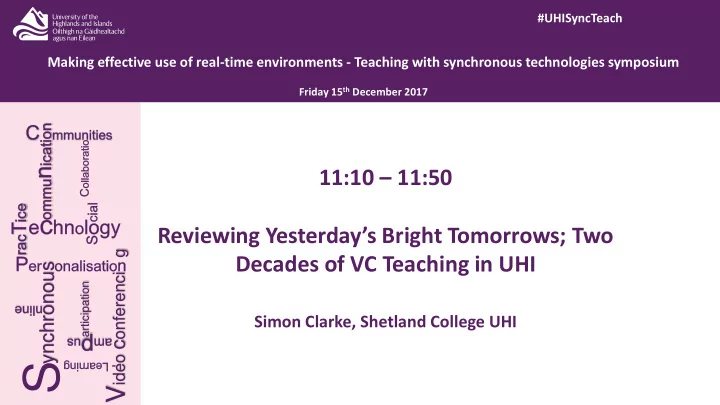

#UHISyncTeach Making effective use of real-time environments - Teaching with synchronous technologies symposium Friday 15 th December 2017 11:10 – 11:50 Reviewing Yesterday’s Bright Tomorrows; Two V ideo c onferenci g Decades of VC Teaching in UHI ynchronous articipation Simon Clarke, Shetland College UHI S
Objectives • To review VC’s development and it use by UHI to date. • Consider obstacles to its more widespread adoption. • Where next? Potential progression from adaptive technology to tactical revolution.
Origins of VC - Videophone • First commercial service operated by German Post Office, 1936-40 starting between Berlin and Leipzig, linked by 160 km of coaxial cable. • 1964 AT&T Picturephone, New York to Washington • Cameras in both cases based on John Logie Baird’s design, transmission was of an analogue signal. Defeated by cost.
Modern Video Conferencing • 1988 ISDN (Integrated Services for Digital Networks) • 1991 first webcam; Trojan Room coffee pot, University of Cambridge • 1990s standards based VC equipment from Tandberg, Polycom etc • 1998 IP (Internet Protocol) VC lowered cost and widened availability • 2005 high definition video – Lifesize VC units
Early VC Teaching at UHI • Single channel VC communication (presentation or main camera), bulky cathode ray monitors • Object / Document Camera
UHI’s Main VC Suites • Main VC Suite Shetland College 2013 • Crestron control unit and interactive PC screen
VC Auditorium • Example Inverness College • Separate cameras for the tutor and local class, speaker controls which image is sent • Note also the “confidence monitor”
Central digital recording • Originally VC recordings posted out to students on tape • Codian Recorder; Up to 15 recordings simultaneously, content accessible over the internet
12 fold increase in VC Usage Chart Title 15000 • 2001/02: 1,091 hours; • 2012/13 :7,956 hours; 10000 • 2016/17 :13,064 hours 5000 (Panciroli et al 2015, 40). 0 2001/02 2012/13 2016/17 • VC teaching used in 69% of undergraduate degrees (as described in the 2017 Prospectus)
Analysis of UHI’s Place in the Scottish HE Sector • Blended online and VC delivery across campuses is UHI’s most distinctive product. • The numbers directly benefitting are modest compared to what could be achieved. Kemp and Lawton 2013, 47-48 Why does VC remain an orphan technology?
Room Set-up, Lighting and Use of the Camera • Put the lights on and address the camera • Close the blinds, or don’t sit in front of the window. • Zoom in to maximise facial expression and body language.
Camera Position and the Local Audience • Trying to address both local and remote audiences. • A distant figure on wide angle.
The Reality of Auditoria Use • UHI’s most expensive spaces are the worst used and least used, often the VC space of last resort • Audience participation from auditoria is extremely difficult
Presentational Technique and its Absence • Illegible presentations • Hardcopy for virtual students • Turning their back to the camera
Lack of Educational Leadership • Vision of UHI “between the OU and a traditional campus - based university” ( Simco and Campbell 2011) is a confused compromise. • Absence of direction on use of technology to achieve networked and off campus programmes (Strategic Vision and Plan 2015-20). • Lack of a clear message in our marketing of the networked product (Prospectus 2018 barely distinguishes between four degree types).
Marketing; 2018 Prospectus • Very different programmes with very similar study method descriptions
Traps avoided! Immersive Telepresence • Individual cameras and individual presentation of participants • Identical furnishings and lighting for all participants • Hi Tech defeated by participant behaviour
PC Based VC • ConferenceMe / Movi / Jabber / Cisco Spark • Desktop or laptop computers serve as VCs with cheap peripherals and free* software downloads.
Student Participation from Off Campus • Well framed and lit image, able to make a presentation by PC-VC • Single figures easier to get to know. • Lone students much more able to interact than those in a group
2017-18 Dial-in Replaces Automated Dial-up • Greater flexibility to reallocate rooms • Requires more discipline – system of warnings and auto cut-off lost.
Removing Barriers to Learning • Step out from behind lecterns and control panels • Facilitate VC learning as first amongst equals, using the same PC based equipment as the students.
Conclusions • Teaching by VC at UHI has continued to grow, even though VC is no longer a novelty – it appears to be addressing a real need. • UHI remains a market leader in VC teaching, not because of its kit, which is rapidly becoming obsolete, but because of its skills base. • Significant improvements have been made in VC kit, which is now easier to use and significantly cheaper to buy and operate. • PC based VC is actually adequate for both staff delivery and student participation. • Most remaining VC problems require a policy or training fix rather than a technological solution.
Recommendations • UHI needs a programme of quality improvement in its VC teaching, primarily focused on staff training. • Individual participation through PC based VC is a better learning experience than via a shared VC suit. This has implications for estates, equipment acquisitions and programme design. • UHI should develop degrees for off campus delivery – there is a student demand, and the experience can be better for both lecturer and student. If we don’t someone else will!
#UHISyncTeach Making effective use of real-time environments - Teaching with synchronous technologies symposium Friday 15 th December 2017 Next up! After the break…… 12:30 – 13:10 Teaching and learning with synchronous and V ideo c onferenci g ynchronous mobile technologies articipation Sarah Cornelius, The University of Aberdeen S Blackboard Collaborate Ultra
Recommend
More recommend